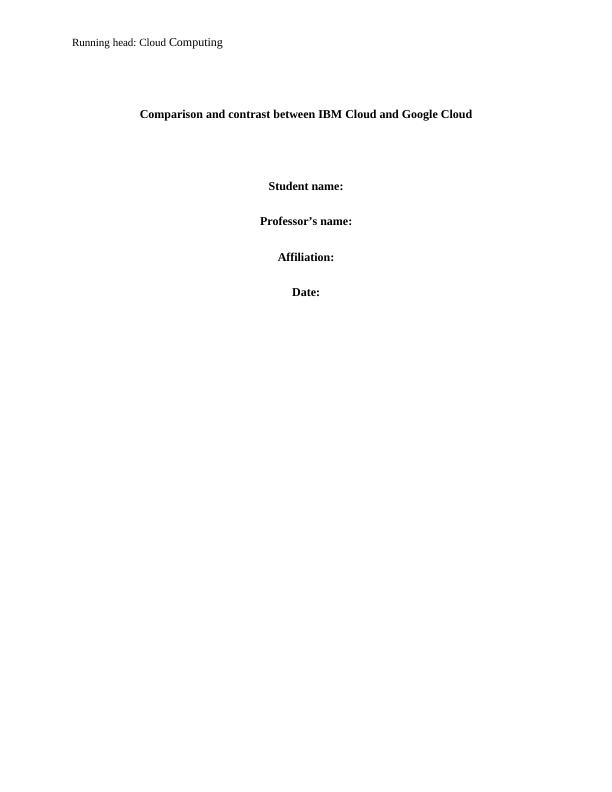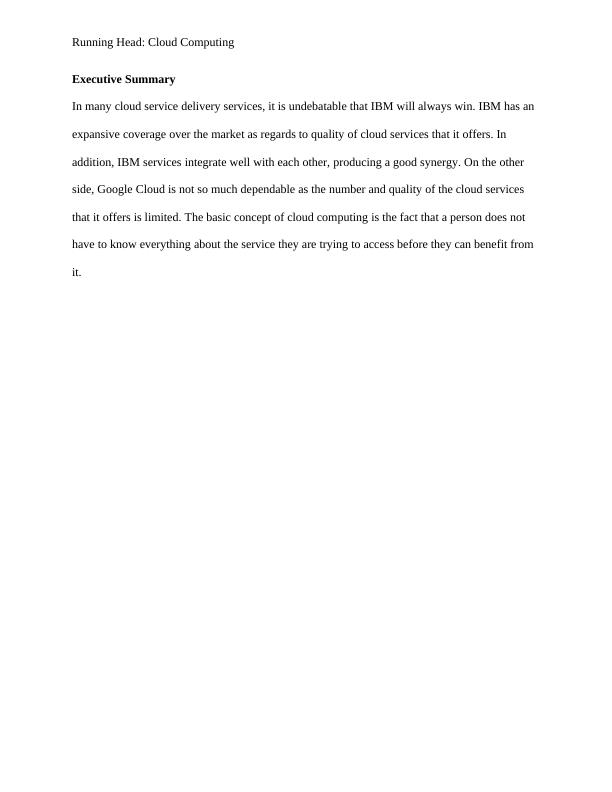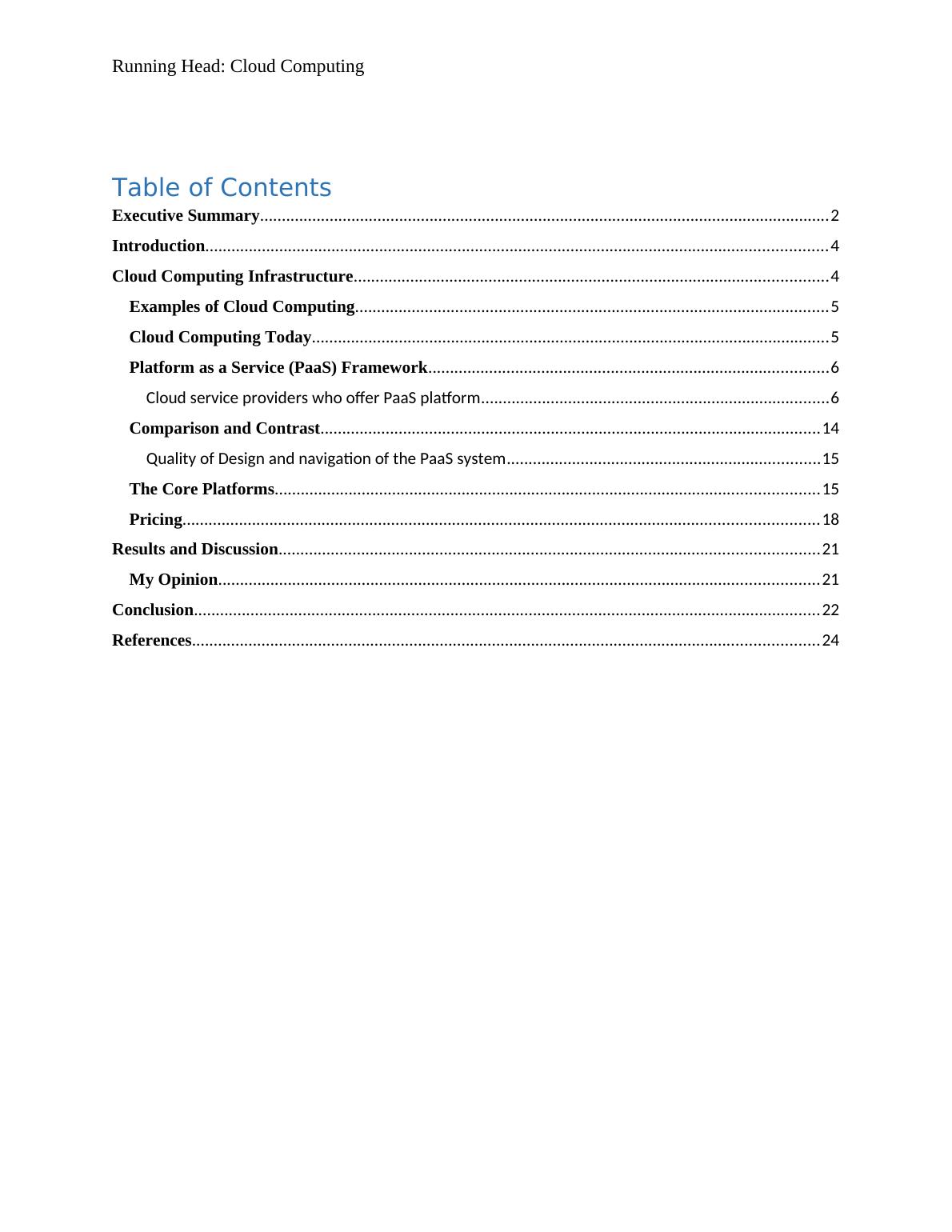Comparison and Contrast: IBM Cloud vs Google Cloud
Added on 2023-01-10
26 Pages5365 Words2 Views
Running head: Cloud Computing
Comparison and contrast between IBM Cloud and Google Cloud
Student name:
Professor’s name:
Affiliation:
Date:
Comparison and contrast between IBM Cloud and Google Cloud
Student name:
Professor’s name:
Affiliation:
Date:

Running Head: Cloud Computing
Executive Summary
In many cloud service delivery services, it is undebatable that IBM will always win. IBM has an
expansive coverage over the market as regards to quality of cloud services that it offers. In
addition, IBM services integrate well with each other, producing a good synergy. On the other
side, Google Cloud is not so much dependable as the number and quality of the cloud services
that it offers is limited. The basic concept of cloud computing is the fact that a person does not
have to know everything about the service they are trying to access before they can benefit from
it.
Executive Summary
In many cloud service delivery services, it is undebatable that IBM will always win. IBM has an
expansive coverage over the market as regards to quality of cloud services that it offers. In
addition, IBM services integrate well with each other, producing a good synergy. On the other
side, Google Cloud is not so much dependable as the number and quality of the cloud services
that it offers is limited. The basic concept of cloud computing is the fact that a person does not
have to know everything about the service they are trying to access before they can benefit from
it.

Running Head: Cloud Computing
Table of Contents
Executive Summary........................................................................................................ 2
Introduction.................................................................................................................. 4
Cloud Computing Infrastructure....................................................................................... 4
Examples of Cloud Computing...................................................................................... 5
Cloud Computing Today.............................................................................................. 5
Platform as a Service (PaaS) Framework.........................................................................6
Cloud service providers who offer PaaS platform.................................................6
Comparison and Contrast........................................................................................... 14
Quality of Design and navigation of the PaaS system........................................15
The Core Platforms................................................................................................... 15
Pricing.................................................................................................................... 18
Results and Discussion................................................................................................... 21
My Opinion.............................................................................................................. 21
Conclusion.................................................................................................................. 22
References.................................................................................................................. 24
Table of Contents
Executive Summary........................................................................................................ 2
Introduction.................................................................................................................. 4
Cloud Computing Infrastructure....................................................................................... 4
Examples of Cloud Computing...................................................................................... 5
Cloud Computing Today.............................................................................................. 5
Platform as a Service (PaaS) Framework.........................................................................6
Cloud service providers who offer PaaS platform.................................................6
Comparison and Contrast........................................................................................... 14
Quality of Design and navigation of the PaaS system........................................15
The Core Platforms................................................................................................... 15
Pricing.................................................................................................................... 18
Results and Discussion................................................................................................... 21
My Opinion.............................................................................................................. 21
Conclusion.................................................................................................................. 22
References.................................................................................................................. 24

Running Head: Cloud Computing
Introduction
Cloud computing is a technology that involves the processing of data in a distributed manner, in
which scalable information resources and capacities are provided as a service in the cloud
(Bernstein 2014). Online cloud services can be accessed through smart devices even from the
remotest areas. The basic concept of cloud computing is the fact that a person does not have to
know everything about the service they are trying to access before they can benefit from it.
Cloud computing technology separates the user of a service from the infrastructure and its
operating procedures, as this are not relevant to the end user (Höfer & Karagiannis 2011).
Cloud Computing Infrastructure
More than one person can access services hosted in the cloud, hence we talk of distributed data
processing in cloud computing. Cloud computing architectures can be categorized in three broad
categories as follows:
i. Infrastructure-as-a-Service (IaaS) – this framework makes it possible for
individuals or organizations to rent computing infrastructure such as servers (physical or
virtual) for storage and networking. Iaas is applicable to businesses or individuals that
would want to control their servicers for themselves.
ii. Platform-as-a-Service (Paas) – this framework comes next after IaaS. It involves
provision of storage and networking services from the cloud. All the storage and
networking resources that developers need in developing applications and software are
provided in this architecture.
Introduction
Cloud computing is a technology that involves the processing of data in a distributed manner, in
which scalable information resources and capacities are provided as a service in the cloud
(Bernstein 2014). Online cloud services can be accessed through smart devices even from the
remotest areas. The basic concept of cloud computing is the fact that a person does not have to
know everything about the service they are trying to access before they can benefit from it.
Cloud computing technology separates the user of a service from the infrastructure and its
operating procedures, as this are not relevant to the end user (Höfer & Karagiannis 2011).
Cloud Computing Infrastructure
More than one person can access services hosted in the cloud, hence we talk of distributed data
processing in cloud computing. Cloud computing architectures can be categorized in three broad
categories as follows:
i. Infrastructure-as-a-Service (IaaS) – this framework makes it possible for
individuals or organizations to rent computing infrastructure such as servers (physical or
virtual) for storage and networking. Iaas is applicable to businesses or individuals that
would want to control their servicers for themselves.
ii. Platform-as-a-Service (Paas) – this framework comes next after IaaS. It involves
provision of storage and networking services from the cloud. All the storage and
networking resources that developers need in developing applications and software are
provided in this architecture.

Running Head: Cloud Computing
iii. Software-as-a-Service (Saas) – this architecture provides for access of hosted
services from the cloud. The used doesn’t need to understate the underlying operating
infrastructure of the framework; the user only needs to access the services they need.
SaaS architecture is normally based on a ‘one- per user’ basis. This means that a user
individually access the cloud to access the services they need from a remote area.
Cloud computing technology makes a wide variety of services available to the user, ranging from
storage capacity, networking and hosting services. Furthermore, integration of artificial
intelligence (AI) and natural language processing technology with cloud computing makes it
even more beneficial to users, as it can then can offer more complex services and resources. .
Examples of Cloud Computing
Cloud computing entails a wide range of services that we use in a day to day lives. For example,
services like Gmail, or our smartphone’s cloud based photo backup and several others are all
based on cloud computing technology. Many business enterprises and organizations also rely on
cloud computing in order to carry out their day to day tasks. Netflix for example relies heavily on
cloud services in order to sustain its business (Zhang et al. 2010).
Cloud Computing Today
More than half of IT spending globally is spent on enhancing cloud computing infrastructure so
as to accommodate more advanced cloud frameworks. At the same time, the traditional in-house
packaging of computing workloads is fast being faced away as more people and businesses are
shifting their services to the cloud (Hoefer & Karagiannis 2010).
iii. Software-as-a-Service (Saas) – this architecture provides for access of hosted
services from the cloud. The used doesn’t need to understate the underlying operating
infrastructure of the framework; the user only needs to access the services they need.
SaaS architecture is normally based on a ‘one- per user’ basis. This means that a user
individually access the cloud to access the services they need from a remote area.
Cloud computing technology makes a wide variety of services available to the user, ranging from
storage capacity, networking and hosting services. Furthermore, integration of artificial
intelligence (AI) and natural language processing technology with cloud computing makes it
even more beneficial to users, as it can then can offer more complex services and resources. .
Examples of Cloud Computing
Cloud computing entails a wide range of services that we use in a day to day lives. For example,
services like Gmail, or our smartphone’s cloud based photo backup and several others are all
based on cloud computing technology. Many business enterprises and organizations also rely on
cloud computing in order to carry out their day to day tasks. Netflix for example relies heavily on
cloud services in order to sustain its business (Zhang et al. 2010).
Cloud Computing Today
More than half of IT spending globally is spent on enhancing cloud computing infrastructure so
as to accommodate more advanced cloud frameworks. At the same time, the traditional in-house
packaging of computing workloads is fast being faced away as more people and businesses are
shifting their services to the cloud (Hoefer & Karagiannis 2010).

Running Head: Cloud Computing
It is predicted that in the next five years, more than a third of the IT budget will be spent in
ameliorating cloud services and proving for hosting more resources in the cloud. By the year
2021, more than half of all global IT enterprises shall have shifted completely to the cloud.
Platform as a Service (PaaS) Framework
Platform as a service (PaaS), as mentioned earlier, is a framework of cloud computing that
makes it possible for individuals and companies to access infrastructural services from the cloud.
PaaS enhances the speed and ease of accessing resources by separating the end user from the
physical interface of the service provider (Madhavaiah & Bashir 2012). This model of cloud
computing enables customers in designing, running and managing applications without having to
worry about the underlying infrastructure. In Paas, the provider supplies all that is needed for
development of software, such as servers, operating systems and storage facilities. The user
accesses these services and resources without having to worry of configurations and adjusting
settings (Sultan 2011).
The original intention of the PaaS framework was to simplify the process of writing code for
developers and software designers. Originally, all the PaaS features for most companies were
hosted in the public cloud. However, because of security concerns, more business enterprises are
adopting the hybrid and private clouds so as to enhance security of their data and resources
(Mollah, Islam & Islam 2012).
Cloud service providers who offer PaaS platform
Globally, there are many business enterprises using services to users based on PaaS platform.
Developers have the right to choose which PaaS providers they want depending on the services
they need. Different companies specialize in offering of a particular type pf servicesand
It is predicted that in the next five years, more than a third of the IT budget will be spent in
ameliorating cloud services and proving for hosting more resources in the cloud. By the year
2021, more than half of all global IT enterprises shall have shifted completely to the cloud.
Platform as a Service (PaaS) Framework
Platform as a service (PaaS), as mentioned earlier, is a framework of cloud computing that
makes it possible for individuals and companies to access infrastructural services from the cloud.
PaaS enhances the speed and ease of accessing resources by separating the end user from the
physical interface of the service provider (Madhavaiah & Bashir 2012). This model of cloud
computing enables customers in designing, running and managing applications without having to
worry about the underlying infrastructure. In Paas, the provider supplies all that is needed for
development of software, such as servers, operating systems and storage facilities. The user
accesses these services and resources without having to worry of configurations and adjusting
settings (Sultan 2011).
The original intention of the PaaS framework was to simplify the process of writing code for
developers and software designers. Originally, all the PaaS features for most companies were
hosted in the public cloud. However, because of security concerns, more business enterprises are
adopting the hybrid and private clouds so as to enhance security of their data and resources
(Mollah, Islam & Islam 2012).
Cloud service providers who offer PaaS platform
Globally, there are many business enterprises using services to users based on PaaS platform.
Developers have the right to choose which PaaS providers they want depending on the services
they need. Different companies specialize in offering of a particular type pf servicesand

End of preview
Want to access all the pages? Upload your documents or become a member.
Related Documents
Cloud-Based Solutions for Organizationslg...
|5
|1040
|382
Cloud Computing: Types, Advantages and Disadvantageslg...
|8
|1314
|485
Integration of Cloud Serviceslg...
|21
|670
|482
Cloud Computing: Benefits and Issues for GTGOVlg...
|12
|1331
|96
Regional Gardens Cloud Computing Architecturelg...
|11
|919
|76
Issues of Cloud Computing and Research Opportunitieslg...
|8
|2180
|443
